Will you be able to listen to these speakers before purchase?
Since you are interested only in the drivers, I suggest that they are removed from the cabinets prior to purchase so that you can inspect the cones from the front.
The tweeter cone has foam damping around its periphery which may have perished.
The foam can be replaced so it's not a deal breaker, but it may be used as a bargaining chip.
Thanks so much for all the info it's super useful.
I had a chat with the seller, he said I can listen when I collect but wasnt happy for me to remove the drivers so ended up buying them for £110 which I think is a pretty good price. & I'm hopefully collecting saturday. Once I've worked out a cabinet design will order some more plywood & hopefully start the build next saturday. I was hoping to build the cabinets a little smaller like a tannoy monitor but going on that link looks like the TWQT is the design I'll have to work out. (this is the frequecy stuff that starts to confuse me so any help on plans greatly apreciated!!
Thanks again
Thanks, I was getting a bit carried away by the excitement of it all!
These classic drivers will hold their value so your money is well spent.
Please post more photos of the actual drivers once you've removed them from the cabinets.
You could ask about enclosure designs for the Super 8 over on the Full Range Loudspeaker sub-forum, but I fear you may have to reap the whirlwind of many conflicting opinions!
How are your woodworking skills as the TWQT is not a simple box?
I've no direct experience with this form of loading, but will see if I can help you with the design if required. First thing needed is the measured diameter of the paper cone and the measured diameter of the cone plus surround in order to estimate the surface area of the vibrating cone. It would be great if you were able measure the actual free air resonance of your actual drivers as we have two conflicting values, 40Hz from Wharfedale and 69Hz when measured by the aforementioned author.
These classic drivers will hold their value so your money is well spent.
Please post more photos of the actual drivers once you've removed them from the cabinets.
You could ask about enclosure designs for the Super 8 over on the Full Range Loudspeaker sub-forum, but I fear you may have to reap the whirlwind of many conflicting opinions!
How are your woodworking skills as the TWQT is not a simple box?
I've no direct experience with this form of loading, but will see if I can help you with the design if required. First thing needed is the measured diameter of the paper cone and the measured diameter of the cone plus surround in order to estimate the surface area of the vibrating cone. It would be great if you were able measure the actual free air resonance of your actual drivers as we have two conflicting values, 40Hz from Wharfedale and 69Hz when measured by the aforementioned author.
Thanks, I was getting a bit carried away by the excitement of it all!
HA! sorry for late reply I've been ill the last couple of days.
Please post more photos of the actual drivers once you've removed them from the cabinets.
Will do, looking forward to getting my hands on them! I've looked at a couple of folded horn designs too but not sure what they add. My woodworking skills are OK. There's a place near me that cuts PLY to size so once I've sorted a design will get the parts cut there & then work out best practice to construct them.
I think that with drivers of this vintage, where the T/S parameters are unknown/uncertain, you are looking for an enclosure which is flexible in its action and not one which is rigidly mathematically defined.
This was certainly the approach taken in the original Wharfedale designs, and it would appear that the TWQT also lends itself to such an approach.
This was certainly the approach taken in the original Wharfedale designs, and it would appear that the TWQT also lends itself to such an approach.
So, I went & picked up the speakers today.
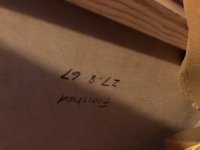
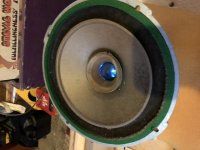
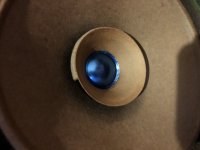
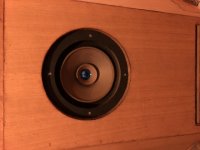
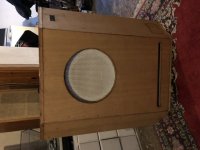
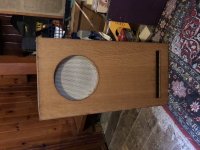
I immediately removed the wire grills & had a look at the drivers which look ok other than the foam around the wizzer cone has deteriorated. Is this replaceable??
They sound pretty sweet, nice & more detailed than my AR4AX. If lacking a tiny bit of bass but that just may be the cabs. Not measured it yet but the smaller cab looks like it’s to the Wharfdale specs thinking I’ll build a new pair of those with the inner fold TWQT design & perhapse increasing the ply to 15mm instead of 12.
When I opened them up the smaller cab had the writing in saying finished 27/8/67 which is pretty cool, the guy I got them off said he’d inherited them from a professor.






I immediately removed the wire grills & had a look at the drivers which look ok other than the foam around the wizzer cone has deteriorated. Is this replaceable??
They sound pretty sweet, nice & more detailed than my AR4AX. If lacking a tiny bit of bass but that just may be the cabs. Not measured it yet but the smaller cab looks like it’s to the Wharfdale specs thinking I’ll build a new pair of those with the inner fold TWQT design & perhapse increasing the ply to 15mm instead of 12.
When I opened them up the smaller cab had the writing in saying finished 27/8/67 which is pretty cool, the guy I got them off said he’d inherited them from a professor.
If you very carefully remove the remainder of the perished foam you can replace it with a home made annulus of soft foam.
Use a tacky PVA adhesive like Anita's Tacky glue or a similar PVA adhesive which is recommended for replacing the foam surround on woofers.
Wharfedale found it necessary to damp the edge of the whizzer cone of the 8" and 10" units to balance the treble response with the rest of the audio range. The 12" units didn't require this edge damping, perhaps because their whizzer cones needed more liveliness for the overall balance.
As to the bass response, the extremely strong magnetic field of the Super 8 exerts tight control on the voice coil and cone movement. This results in bass which is quick and tight and which may at first appear to be lacking in 'oomph'.
The Wharfedale enclosures were designed to produce a 'true to life' bass response. A differently designed enclosure may yield more bass weight, but don't expect subwoofer type response!
P.S. Thanks for the pics!
Use a tacky PVA adhesive like Anita's Tacky glue or a similar PVA adhesive which is recommended for replacing the foam surround on woofers.
Wharfedale found it necessary to damp the edge of the whizzer cone of the 8" and 10" units to balance the treble response with the rest of the audio range. The 12" units didn't require this edge damping, perhaps because their whizzer cones needed more liveliness for the overall balance.
As to the bass response, the extremely strong magnetic field of the Super 8 exerts tight control on the voice coil and cone movement. This results in bass which is quick and tight and which may at first appear to be lacking in 'oomph'.
The Wharfedale enclosures were designed to produce a 'true to life' bass response. A differently designed enclosure may yield more bass weight, but don't expect subwoofer type response!
P.S. Thanks for the pics!
Last edited:
Hi painted, thanks for backing me up (I think!) as I was in danger of being a one man band!IT is about the field strength in the gap.
The field strength in the air gap of the Super 8 was 1.45 Tesla - a figure that could only be achieved at the time by using high quality steel in the magnet construction.
I agree that the speakers may be nothing magical in today's terms - but oh, that period sound!
I’ve listened more this evening, they really do sing these speakers & on vocals & acoustics & actually on kraftwerk they sounded amazing, I got lost!! In terms of bass I think because of the size of the cabinets I was expecting a more oomphy bass but it’s def there & no less than my current speakers. In fact switching back to the AR’s they sounded muddy. I’m super happy with these & do think if I build some new matching cabs they will look as good as they sound.
One thing I was wondering & may try on the current cab is if there is any benefit to mounting the driver on the outside of the cab?
One thing I was wondering & may try on the current cab is if there is any benefit to mounting the driver on the outside of the cab?
If you very carefully remove the remainder of the perished foam you can replace it with a home made annulus of soft foam.
Use a tacky PVA adhesive like Anita's Tacky glue or a similar PVA adhesive which is recommended for replacing the foam surround on woofers.
I've ordered a mic foam cover which I think should be a spot on diameter so i can cut a ring from, hopefully the foam will be a suitable density if not I'm guessing I'll just cut some from some foam I've used for chair padding in the past.
@galu, wondering if you could help with the calculations for the TQWT?
Hoping to order some PLY today & start construction at the weekend.
If I'm building to the wharfedale specs of a cabinet 24"x11" x9 do I still follow the advice on their specs of a 9" x 1" vent on the front?
Regarding TQWT calculations, see my post #22 for required measurements from you.@galu, wondering if you could help with the calculations for the TQWT?
If I'm building to the wharfedale specs of a cabinet 24"x11" x9 do I still follow the advice on their specs of a 9" x 1" vent on the front?
The dimensions of the vent in the Wharfedale cabinet design were not arrived at by theory. Instead they were chosen 'by ear'. The method of vent tuning back in the day was to tune the vent to the free air resonant frequency of the driver. However, in the case of drivers with a resonant frequency above 50Hz, sharp reflex tuning was said to be 'a doubtful blessing' and a larger than theoretical vent was employed.
If the T/S parameters of your particular Super 8s were accurately known, then we could design a bespoke tuned enclosure. However, some rough calculations I have done using the measured parameters provided earlier suggest you would require a much larger enclosure.
I have found this information regarding the foam annulus that was supplied by VaNarn in 2016:
For the Wharfedale 8 RS DD and the 10 RS DD model, the foam used for the damping ring on the HF cone is made from a soft 1/4'' thick plastic foam with small pores. It was cut out from a sheet of foam as an annulus, I.D. = 2.75''; O.D.= 3.5''. A section, approx. a quarter of the circumference, was removed to allow it to be fitted to the edge of the tweeter cone. A latex adhesive should be used to attach it and it must be tensioned in such a way as to to provide a small amount of compression to the cone edge.
Example 1 in the link below shows a TQWT enclosure that will not be too far removed from one which is suitable for the Super 8.
Tapered Quarter Wave Tube
The dimensions (h x w x d) are 1000 x 220 x 350mm so this may help you to decide whether you wish to pursue this enclosure design further.
Tapered Quarter Wave Tube
The dimensions (h x w x d) are 1000 x 220 x 350mm so this may help you to decide whether you wish to pursue this enclosure design further.
Example 1 in the link below shows a TQWT enclosure that will not be too far removed from one which is suitable for the Super 8.
Tapered Quarter Wave Tube
The dimensions (h x w x d) are 1000 x 220 x 350mm so this may help you to decide whether you wish to pursue this enclosure design further.
Thanks so much Galu, that's great info on the foam, i'll see what the mic cover is like when it turns up & dig out some other scraps I have to see which is most suitable. I measured the cone as 147mm across & with the surround up to the green 177mm
Looking at that page I think the increase in size to create this style of cab may make them too big for my tiny house (& for my partner!) So will probably stick with a wharfedale spec size very similar to the one one is currently in.
As long as you stick close to the Wharfedale spec for the internal volume (within 10%), you can make the enclosure taller, narrower and deeper to match modern domestic tastes.
You could also listen to the performance of the Super 8 while the cabinet is still sealed and before committing yourself to creating a slot vent opening.
Even after committing to a slot vent, you can experiment by covering it with soft cloth or filling it with BAF wadding which reduces the effective area of the vent.
It's all about experimenting with this vintage driver. Have fun and keep us up to date on your progress.
You could also listen to the performance of the Super 8 while the cabinet is still sealed and before committing yourself to creating a slot vent opening.
Even after committing to a slot vent, you can experiment by covering it with soft cloth or filling it with BAF wadding which reduces the effective area of the vent.
It's all about experimenting with this vintage driver. Have fun and keep us up to date on your progress.
So... cabinets coming along. As suggested I left them unported to see what they’re like first.
I’d not disassembled the old ported cab so could use it for comparison & it must be said port really does make a difference, much more bass & feels like detail gets a bit lost on the imported cab.
On the wharfedale specs it mentions lining the cabinet on all 4 sides with ‘back lined soft cloth, 1” thick’ Wondering if you had any suggestions or if this is just the same as foam/rockwool stuffing?
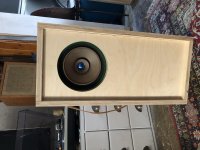
I’d not disassembled the old ported cab so could use it for comparison & it must be said port really does make a difference, much more bass & feels like detail gets a bit lost on the imported cab.
On the wharfedale specs it mentions lining the cabinet on all 4 sides with ‘back lined soft cloth, 1” thick’ Wondering if you had any suggestions or if this is just the same as foam/rockwool stuffing?

Hi Ian!
My 807s are now 50 years old and functioning sweetly. Hope I never have to replace them as the going rate at auction is £100 to £150 for a single NOS valve.
eh???
Last edited:
As far as I am aware, there is no direct equivalent to the ECC807.eh???
The Valve Museum describes the ECC807 as being "sensibly equivalent to 13D7" - a valve with which I am not familiar.
ECC807 @ The Valve Museum
Could you be thinking of the ECL807?
P.S. I see you have edited your post.
- Status
- This old topic is closed. If you want to reopen this topic, contact a moderator using the "Report Post" button.
- Home
- Amplifiers
- Tubes / Valves
- Rogers Cadet MK3 using the Power Amp with a different Pre amp